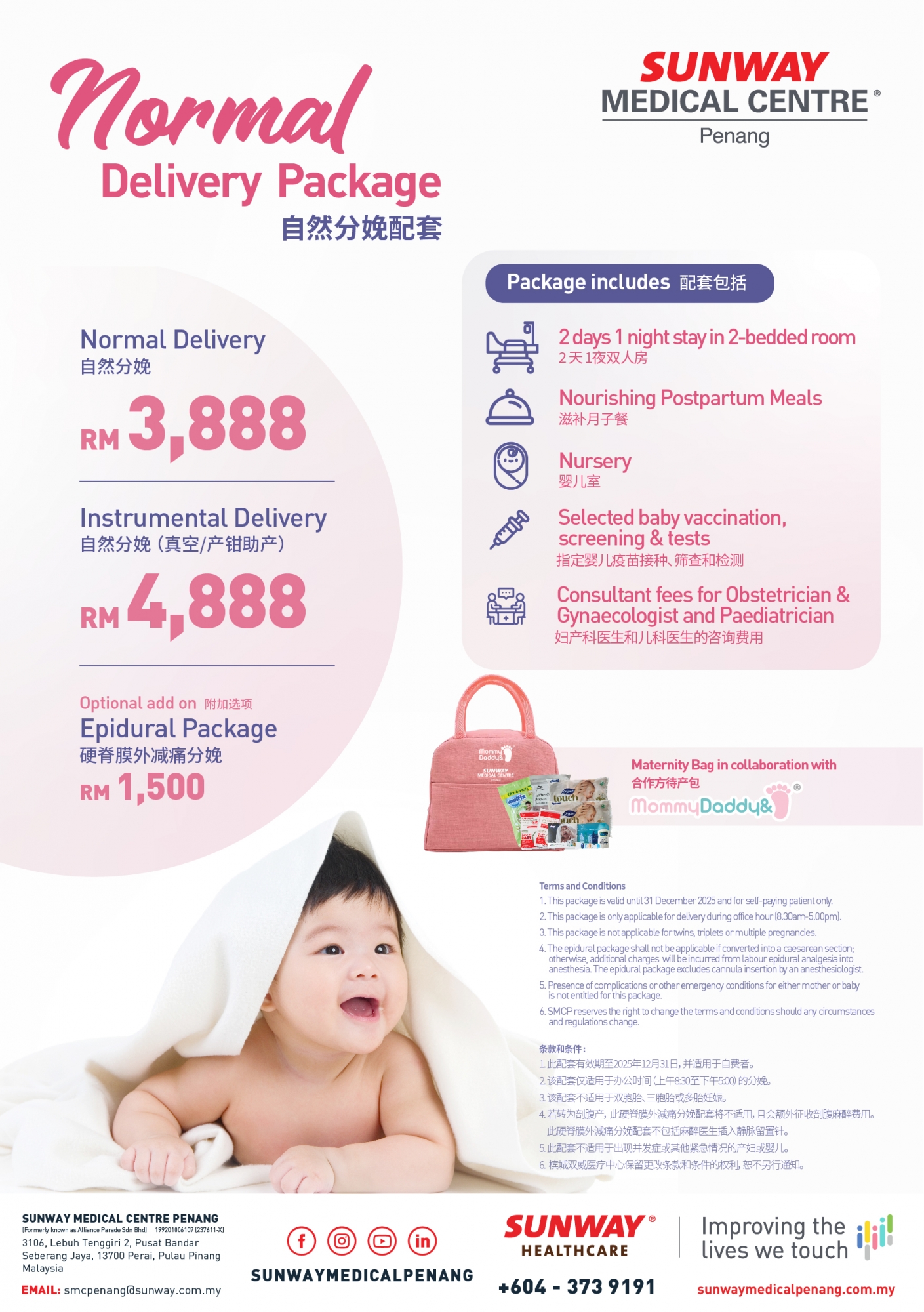At Sunway Medical Centre Penang, our lactation counselling services are designed to support mothers throughout their breastfeeding journey. Our team provides personalized guidance and practical assistance to address breastfeeding challenges and promote successful breastfeeding experiences.
Our Services Include:
-
Antenatal & Postnatal Counselling:
- Educating and preparing mothers for exclusive breastfeeding before and after delivery.
-
Delivery Suite Support:
- Assisting with skin-to-skin contact and early initiation of breastfeeding immediately after birth.
-
Postnatal Assistance:
- Helping mothers with proper breastfeeding positioning and attachment techniques.
- Counselling and managing breastfeeding challenges, including pain, latching difficulties, and low milk supply.
-
NICU Support:
- Guiding mothers of NICU-admitted babies on stimulating milk production and expressing breast milk for their babies.
-
Specialized Care & Referrals:
- Addressing specific breastfeeding challenges such as breast engorgement, cracked nipples, blocked ducts, nipple confusion, poor attachment, inverted nipples, and insufficient milk supply.
- Referrals to clinics for further management or treatment when necessary.
-
Education for Healthcare Staff:
- Providing training to maternity and nursery staff on supporting breastfeeding mothers.
- Educating staff on compassionate care for non-breastfeeding mothers.
-
Community Engagement:
- Participating in antenatal classes and breastfeeding awareness events.
- Organizing activities to promote the benefits of breastfeeding and empower mothers.
Our commitment to nurturing mother and child extends beyond medical care, offering ongoing support and education to ensure a positive breastfeeding journey for every family.
At Sunway Medical Centre Penang, we take pride in supporting and empowering mothers at every stage of their breastfeeding journey. In line with our commitment to maternal and child health, we are proud to join the global celebration of World Breastfeeding Week, this coming 11 – 15 August. This important initiative highlights the vital role of breastfeeding in building a healthier future, and we are excited to be part of this worldwide movement.
Malaysia's National Breastfeeding Policy
In line with global health recommendations, the Ministry of Health Malaysia strongly encourages all mothers to practice exclusive breastfeeding from birth up to the first six months of life. This means infants should be fed only breast milk, without any additional water, formula, or solid food during this period.
From six months onwards, appropriate complementary foods should be introduced while continuing to breastfeed. Mothers are encouraged to continue breastfeeding up to two years of age or beyond, as breast milk remains a vital source of nutrition, immunity, and bonding.
This national policy supports the health and well-being of both mother and child, aiming to reduce infant morbidity and promote long-term development.
Why Breastfeeding Is Essential for Your Baby’s Health and Development
Breastfeeding offers unmatched health benefits for your baby, especially in the crucial first months of life. Breast milk is uniquely designed to meet your baby’s nutritional and developmental needs — naturally and completely.
Benefits of Breastfeeding for the Baby:
-
✅ Complete Nutrition: Breast milk contains all the essential nutrients—including proteins, fats, vitamins, and minerals—needed for healthy growth and development.
-
✅ Easy to Digest: Specially formulated for infants, breast milk is gentle on your baby’s digestive system and reduces the risk of constipation or upset stomach.
-
✅ Natural Immunity: Rich in antibodies and immune-boosting properties, breast milk helps protect your baby from common infections, colds, diarrhea, and allergies.
-
✅ Reduced Risk of Diseases: Breastfed babies have a lower risk of developing chronic conditions such as asthma, diabetes, and childhood obesity.
-
✅ Brain & Emotional Development: Breastfeeding supports optimal brain development and helps build a strong emotional bond between mother and baby, fostering security and well-being.
"Breastfeeding is more than just feeding—it's the foundation of lifelong health".
Health Benefits of Breastfeeding for Mothers
Breastfeeding not only supports your baby’s health—it also offers powerful health and emotional benefits for mothers. This natural process plays an important role in postpartum recovery and long-term wellness.
Benefits of Breastfeeding for the Mother:
-
✅ Speeds Up Recovery: Breastfeeding helps the uterus contract faster after childbirth, reducing the risk of complications and aiding postpartum healing.
-
✅ Reduces Postpartum Bleeding: It promotes the release of oxytocin, which helps minimize blood loss following delivery.
-
✅ Supports Weight Loss: Breastfeeding naturally burns extra calories, helping many mothers return to their pre-pregnancy weight more easily.
-
✅ Lowers Cancer Risk: Long-term breastfeeding is linked to a reduced risk of breast and ovarian cancer, as well as osteoporosis.
-
✅ Enhances Emotional Bonding: The physical closeness and hormone release during breastfeeding help strengthen the emotional connection between mother and baby.
"Breastfeeding is a rewarding journey that nurtures both body and heart—providing
lifelong benefits for both mother and child."
The Power of Skin-to-Skin Contact After Birth
Skin-to-skin contact, also known as kangaroo care, involves placing your newborn on your chest immediately after delivery—ideally for at least one hour. This early bonding moment plays a critical role in promoting successful breastfeeding and supporting your baby’s transition to life outside the womb.
Benefits of Skin-to-Skin Contact:
-
✅ Encourages Early Breastfeeding Initiation: Babies instinctively move toward the breast and begin to latch when held skin-to-skin shortly after birth.
-
✅ Regulates Vital Signs: Helps stabilize the baby’s body temperature, heart rate, and breathing.
-
✅ Calms and Soothes: Reduces crying and comforts the baby through the warmth, heartbeat, and scent of the mother.
-
✅ Boosts Breastmilk Production: Stimulates the release of oxytocin and prolactin, hormones essential for milk production and let-down.
-
✅ Enhances Feeding Cues Awareness: Mothers learn to recognize early hunger cues and respond to their baby’s natural instincts to feed and latch effectively.
"At Sunway Medical Centre Penang, our team supports and guides mothers during this precious first hour, ensuring a strong start to both breastfeeding success and mother-baby bonding".
Feeding on Demand (Baby-Led Feeding): Responding to Your Baby’s Needs Naturally
Feeding on demand, also known as baby-led feeding, means allowing your baby to breastfeed whenever they show signs of hunger—rather than following a strict schedule. This responsive approach helps ensure your baby gets the nourishment they need, supports milk production, and strengthens the mother-baby bond.
Key Guidelines for Feeding on Demand:
-
✅ Watch for Hunger Cues: Let your baby feed whenever they show early signs of hunger, such as sucking motions, rooting, or restlessness—don’t wait for crying.
-
✅ Feed Until Baby is Satisfied: Allow your baby to breastfeed for as long as they need, and let them release the breast on their own when full.
-
✅ Relieve Full Breasts: If your breasts feel engorged or full, offer a feed to stay comfortable and maintain milk flow.
-
✅ Wake for Feeds if Necessary: If your baby sleeps for long periods, gently wake them to breastfeed—especially in the early weeks when frequent feeding supports healthy weight gain.
"Baby-led feeding respects your baby’s natural rhythms and promotes a healthy breastfeeding relationship from the start."
The Importance of Frequent Breastfeeding to Maintain a Healthy Milk Supply
To establish and maintain a good milk supply, it’s essential to breastfeed your baby frequently, both day and night, in response to their feeding cues. The more often your baby nurses, the more signals your body receives to produce milk—ensuring your baby receives enough nourishment for healthy growth.
Tips to Support and Maintain Adequate Milk Production:
-
✅ Breastfeed On Demand: Feed your baby whenever they show signs of hunger—rooting, sucking, or restlessness—not just by the clock.
-
✅ Empty the Breasts Fully: If your breasts still feel full after a feeding session, express the remaining milk to avoid engorgement and stimulate supply.
-
✅ Pump While Nursing: Use a breast pump on one side while your baby feeds on the other to increase stimulation and milk output.
-
✅ Stay Hydrated & Nourished: Drink plenty of fluids, eat a balanced diet, and get as much rest as possible to support your body’s milk-making process.
-
✅ Maximize Direct Feeding: On non-working days, breastfeed directly to maintain strong milk flow and mother-baby bonding.
-
✅ Express Milk at Work: If you’re a working mom, pump regularly during office hours to maintain supply and reduce discomfort.
-
✅ Feed Around Work Hours: Breastfeed before leaving for work and as soon as you return home to reconnect and continue milk production naturally.
"Consistent breastfeeding and self-care are key to maintaining a steady milk supply—nurturing both your baby’s health and your breastfeeding journey".
Understanding Baby Hunger Cues
Newborns communicate their needs through body language long before they begin to cry. Recognizing early hunger cues can help you respond quickly and calmly, making breastfeeding or bottle-feeding more effective and soothing for both you and your baby. Every baby is different, but most will show signs of hunger through subtle movements, sounds, and gestures.
By learning to spot these signals early, you can help your baby feed more comfortably and avoid the stress that often comes with late feeding cues like crying. This responsive feeding approach also supports bonding, builds trust, and encourages better milk flow for breastfeeding mothers.
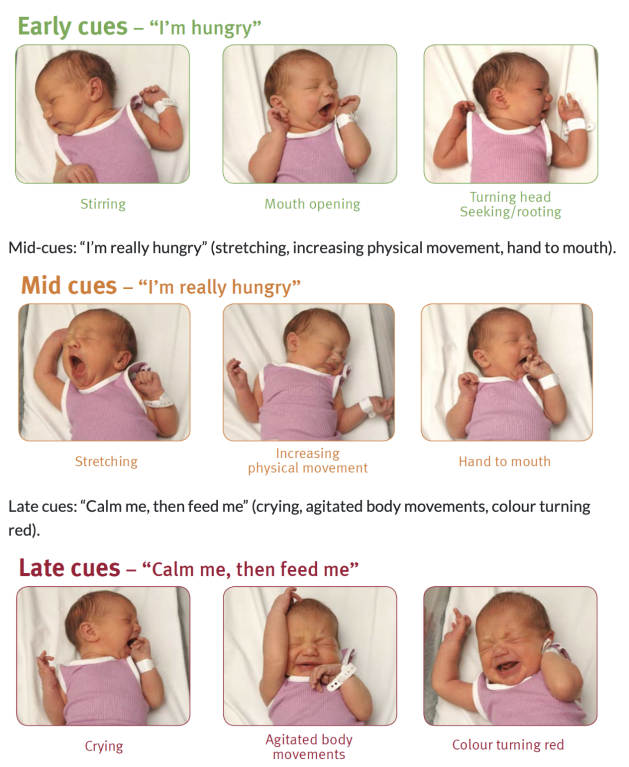
The Importance of Early Initiation of Breastfeeding
Breastfeeding within the first hour after birth—often called the "golden hour"—is one of the most important steps in ensuring a healthy start for your newborn. This early initiation allows the baby to receive colostrum, the first form of breast milk, which is rich in antibodies, nutrients, and protective factors.
Early breastfeeding also plays a key role in:
-
Boosting the baby's immune system and reducing the risk of infections
-
Creating a strong emotional bond between mother and baby
-
Stimulating breast milk production and supporting long-term breastfeeding success
-
Helping the mother's uterus contract, reducing postpartum bleeding
"By initiating breastfeeding early, mothers and newborns can benefit from improved health outcomes, better bonding, and a smoother start to the breastfeeding journey".
What is Colostrum?
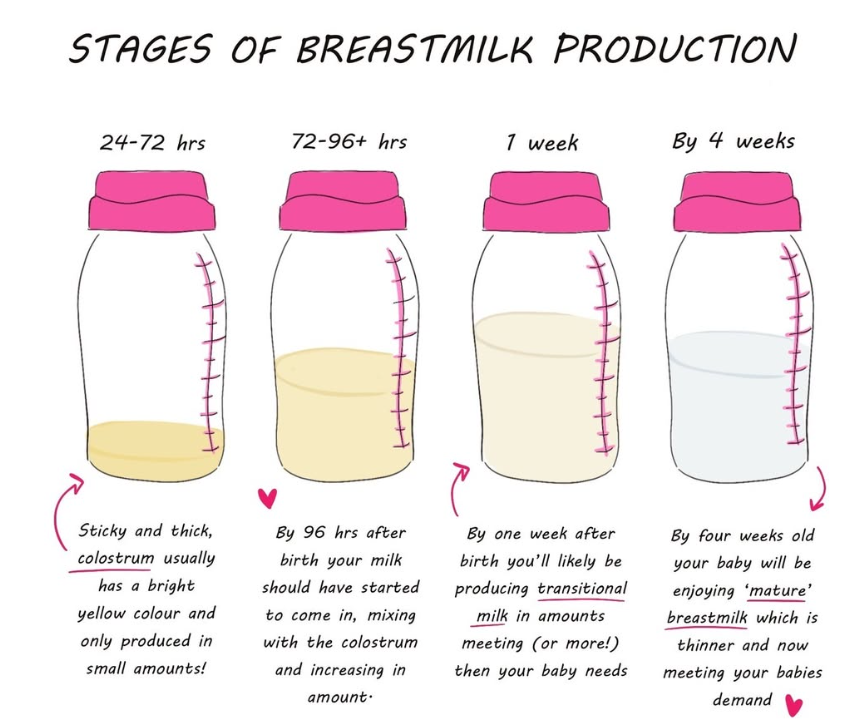
Colostrum is the first form of breast milk produced by the mother’s body after childbirth—often referred to as “liquid gold” due to its rich yellow color and powerful health benefits.
It is:
-
Nutrient-dense and antibody-rich
-
Packed with immune-boosting properties to protect newborns from infections
-
Thicker and more yellow than mature breast milk
-
Produced in small amounts—just the right quantity for a newborn’s tiny stomach
Colostrum plays a crucial role in building your baby’s immune system, supporting gut development, and helping to clear the baby's first stool (meconium).
Within 2 to 4 days, colostrum gradually transitions into mature breast milk, but its early impact on your baby’s health is long-lasting.
What is Rooming-In?
Rooming-in is the practice of keeping your newborn baby with you in the same room 24 hours a day during your hospital stay, rather than being cared for separately in a nursery.
This approach offers numerous benefits for both mother and baby:
-
Strengthens bonding through constant skin-to-skin contact and emotional closeness
-
Supports successful breastfeeding by allowing mothers to respond promptly to hunger cues
-
Reduces maternal stress and anxiety by keeping baby close
-
Helps parents recognize baby’s signals and better understand feeding, sleeping, and comfort needs
-
Builds confidence in newborn care before going home
Rooming-in encourages a more natural, responsive start to parenting, laying the foundation for a healthy and connected relationship from the very beginning.
Handling Expressed Breast Milk: Why It Matters
Properly handling expressed breast milk is essential to keep it safe, clean, and full of nutrients for your baby. Whether you’re returning to work, building a milk supply, or managing breastfeeding challenges, following the right techniques helps protect your baby’s health and ensures every drop of milk counts.
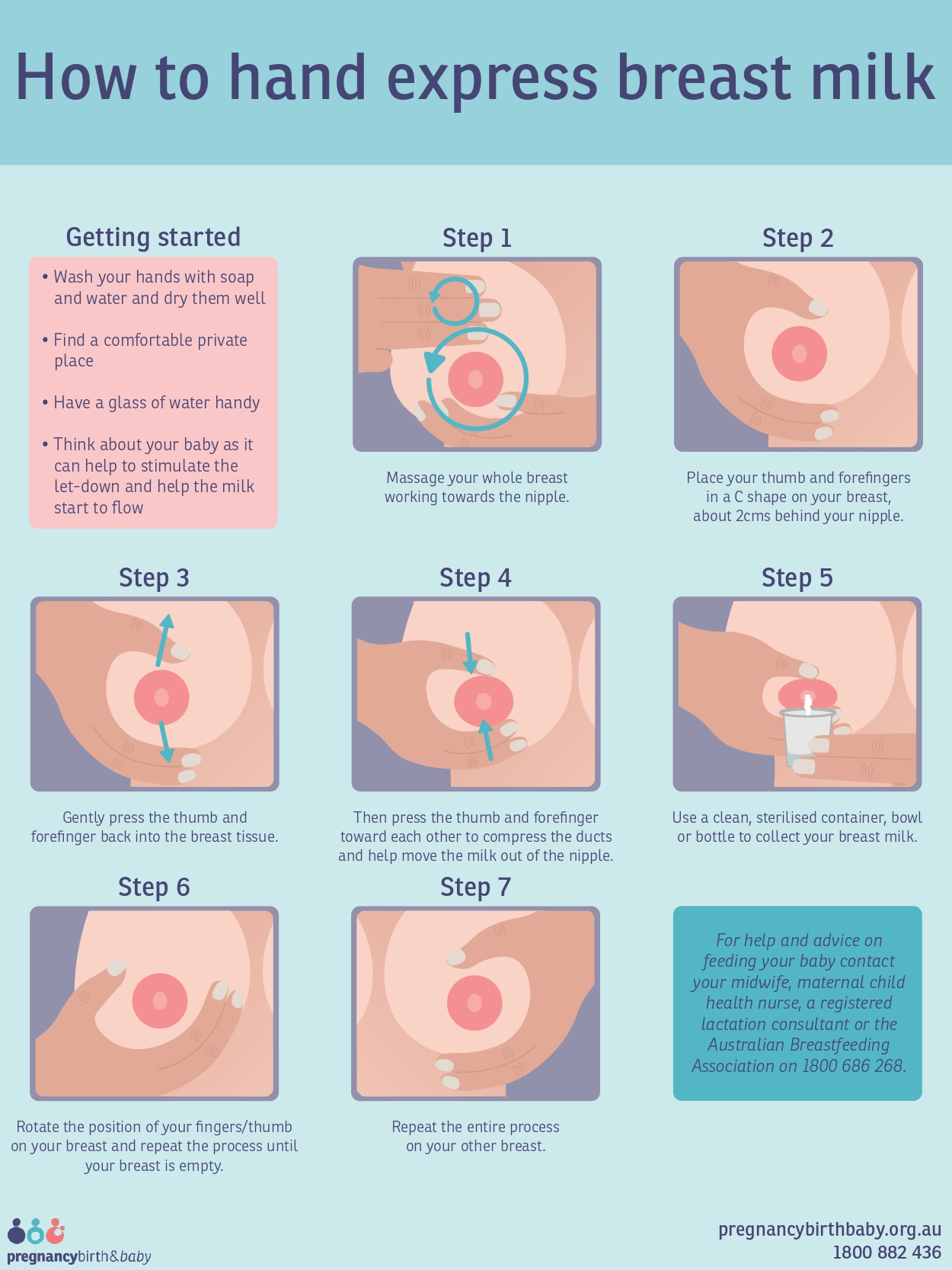
"Expressing breast milk is an important part of the breastfeeding journey, especially for mothers who may be away from their baby or facing temporary feeding challenges. It allows mothers to maintain their breast milk supply, ensure continued nourishment for their baby, and manage breastfeeding more comfortably".
Benefits of Expressing Breast Milk:
-
✅ Supports Ongoing Milk Production
Regular expression keeps the milk supply active, especially when direct breastfeeding isn’t possible. -
✅ Relieves Breast Engorgement & Blocked Ducts
Expressing milk helps reduce discomfort from fullness and prevents complications like mastitis, allowing for easier breastfeeding. -
✅ Prepares the Breast for Better Latching
Softening the areola through expression makes it easier for the baby to latch effectively, especially in the early days after birth.
Whether using hand expression or a breast pump, knowing how to express and store breast milk properly is essential for both mother and baby’s well-being.
The Importance of Good Positioning and Attachment During Breastfeeding
Achieving the right position and attachment during breastfeeding is crucial for both mother and baby. Proper positioning ensures that the baby latches onto the breast effectively, helping them feed comfortably and efficiently—while preventing pain or complications for the mother.
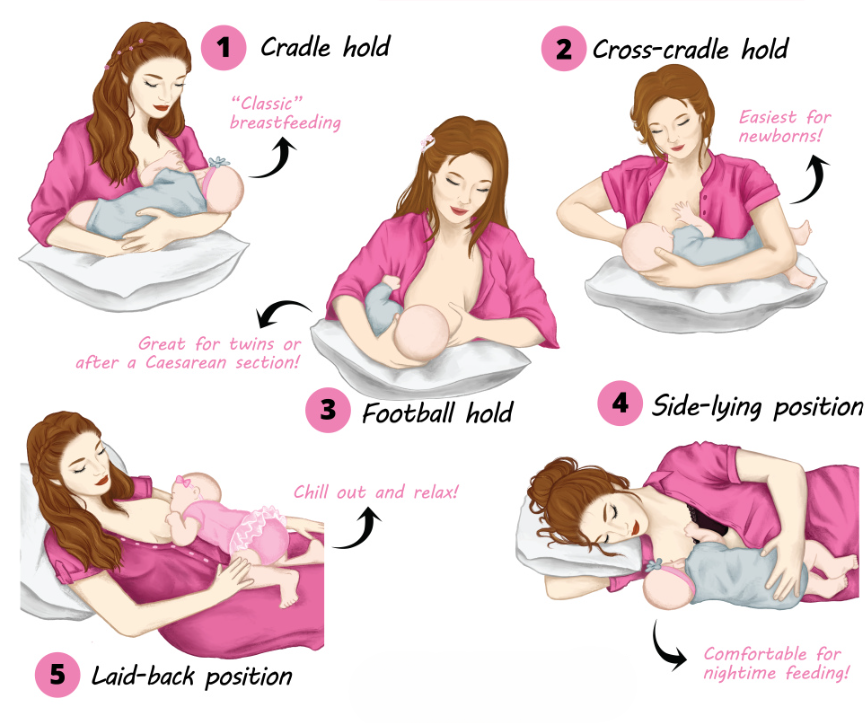
When a baby is well-positioned and correctly attached to the breast, it:
-
✅ Promotes effective milk transfer and helps the baby gain weight steadily
-
✅ Prevents nipple pain, soreness, and cracks
-
✅ Reduces the risk of blocked ducts and mastitis
-
✅ Helps maintain good milk supply
-
✅ Creates a calm and satisfying feeding experience for both baby and mother
Common signs of a good latch include the baby's mouth wide open, chin touching the breast, and more of the areola visible above the baby’s top lip than below the bottom.
Good Positioning for Baby During Breastfeeding
A well-positioned baby is key to a successful and comfortable breastfeeding experience. When your baby is correctly positioned, it helps them latch deeply and feed effectively, while also preventing nipple pain and breastfeeding challenges.
Here are the key elements of proper baby positioning during breastfeeding:
-
✅ Body in line: Your baby’s head, shoulders, and hips should be in a straight line—not twisted—to allow easy swallowing.
-
✅ Close to mother: Hold your baby close to your body, tummy-to-tummy. Always bring your baby to your breast—not your breast to the baby.
-
✅ Head and shoulders supported: Gently support your baby’s head and upper body, especially for newborns or premature babies who need extra care.
-
✅ Facing the breast: Make sure your baby’s face is turned toward your breast, with their nose aligned to your nipple for a good latch.
Proper positioning encourages a calm, nurturing feeding session while helping your baby get the most out of every feed.
Sample Breastfeeding & Pumping Schedule (After 4 Weeks Postpartum)
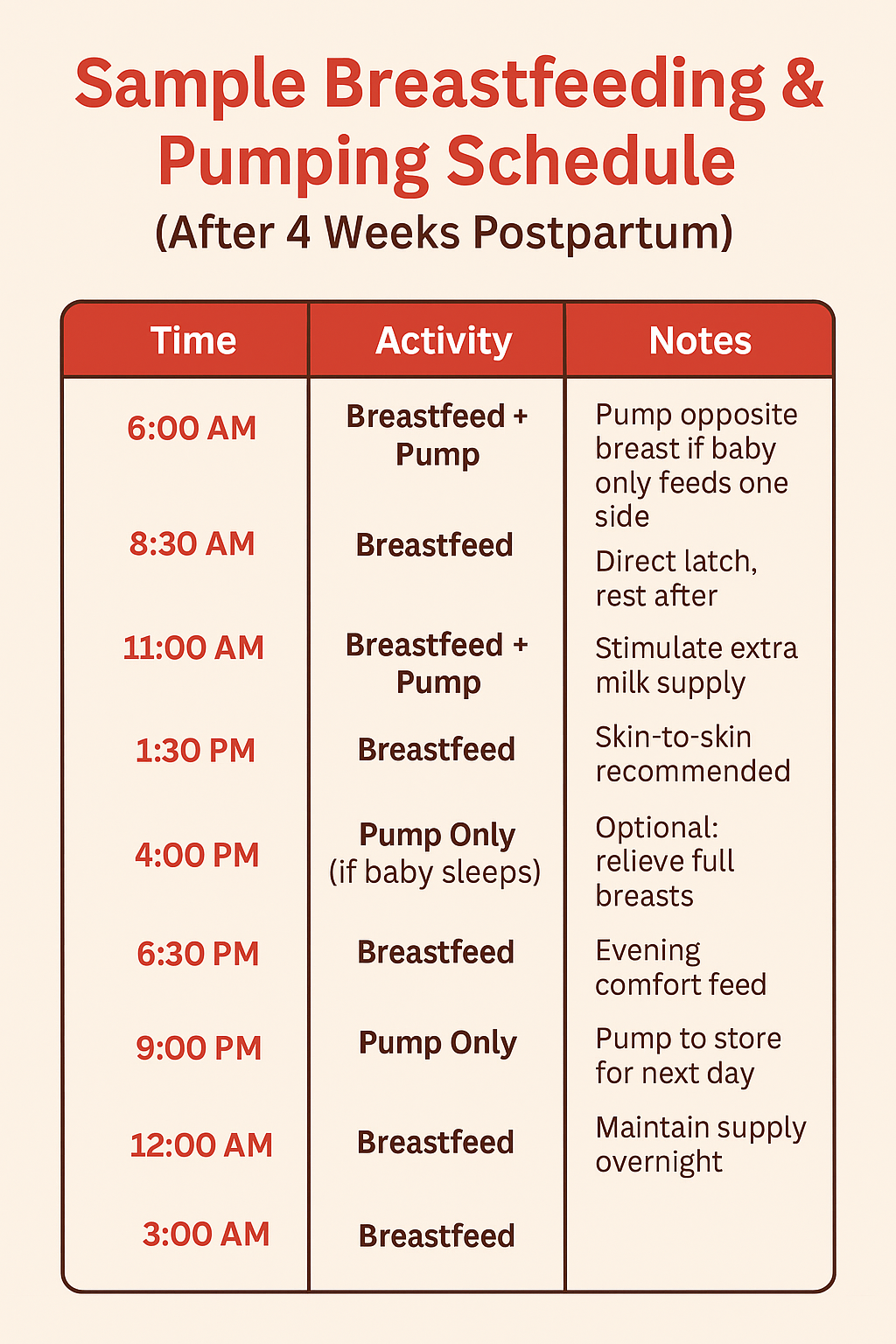
Tips:
-
Start this routine after 4 weeks postpartum, once breastfeeding is well established.
-
Always store pumped milk safely (label with date & time).
-
Stay hydrated and rest whenever possible.
Breastfeeding and Pumping During Maternity Leave
During your maternity leave, it's highly encouraged to exclusively breastfeed your baby to establish a strong milk supply and support your baby’s growth and immunity. As your breastfeeding routine becomes more stable, many mothers begin pumping and storing breast milk to prepare for the transition back to work.
To help you get started, follow a breast milk expression and storage schedule like the one below. This routine is recommended to begin at least 4 weeks after birth, once breastfeeding is well established.
By following a consistent pumping schedule, you can maintain milk production, build up a milk stash, and ensure your baby continues to receive the benefits of breast milk—even when you're away.
How to Safely Thaw Breast Milk
-
Thawing frozen breast milk properly is important to preserve its nutrients and protect your baby from bacteria. Follow these simple steps for safe and effective thawing:
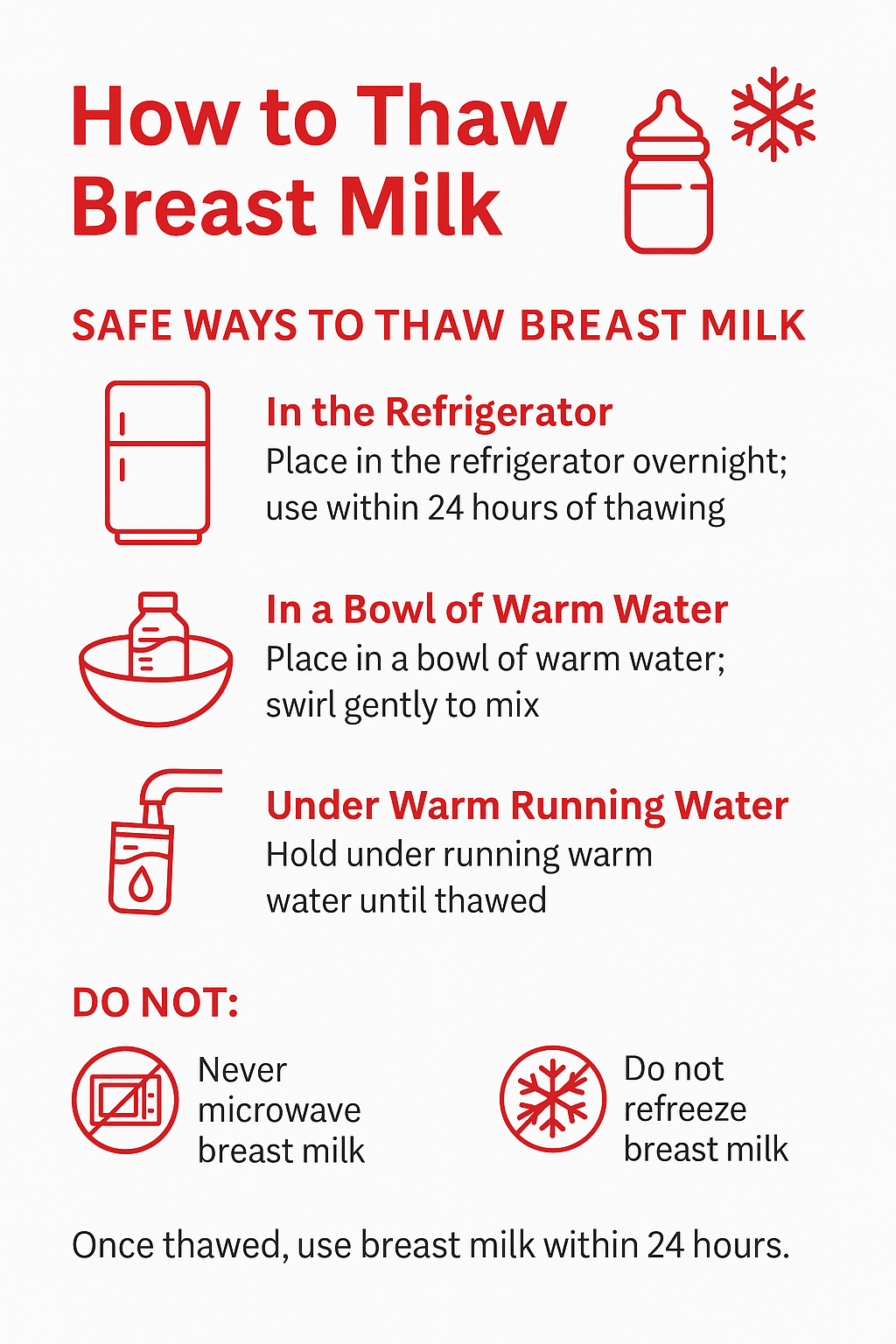
How to Warm Breast Milk Safely
Warming breast milk correctly is essential to preserve its nutrients, antibodies, and natural goodness. Whether it’s freshly expressed or thawed from frozen, breast milk should be gently warmed — not overheated — before feeding.
Safe Ways to Warm Breast Milk:
-
In a Bowl of Warm Water
-
Fill a clean bowl or cup with warm (not boiling) water.
-
Place the sealed milk bag or bottle into the bowl.
-
Let it sit for a few minutes until it reaches body temperature (about 37°C).
-
Swirl gently to mix the fat (do not shake).
-
-
Using a Bottle Warmer
-
Follow the manufacturer's instructions.
-
Ensure the milk is heated evenly and not too hot.
-
Always test on your wrist before feeding.
Important Tips:
-
-
Never microwave breast milk — it can create hot spots and damage nutrients.
-
Do not overheat — milk should be lukewarm, not hot.
-
Always test the milk temperature before giving it to your baby.
-
Use warmed milk within 1–2 hours and discard any leftovers after feeding.
General Guidelines for Handling Expressed Breast Milk
To ensure your baby receives safe, clean, and nutritious breast milk, it’s important to follow proper hygiene and storage practices. Here are some key tips:
-
✅ Always wash your hands thoroughly before handling breast milk or any pumping equipment.
-
✅ Use clean, food-grade containers — preferably glass or BPA-free plastic bottles with secure lids.
-
These simple steps help protect the quality of your milk and support your baby’s health and development.
-
✅ Ensure containers are clean and sterile by washing them with soap and rinsing with hot water before each use.
-
✅ Store milk in small amounts — usually 2 to 5 oz (60–150 ml) per container — based on your baby's feeding needs.
-
✅ Label each container with your baby’s name (if in shared care) and the date of expression, especially if you're storing multiple bottles.
-
✅ Follow the “first in, first out” rule — always use the oldest expressed milk first.
Quick Guides For Breast Milk Storage Guide
Proper breast milk storage keeps your milk safe, fresh, and full of nutrients for your baby. Follow these simple guidelines:
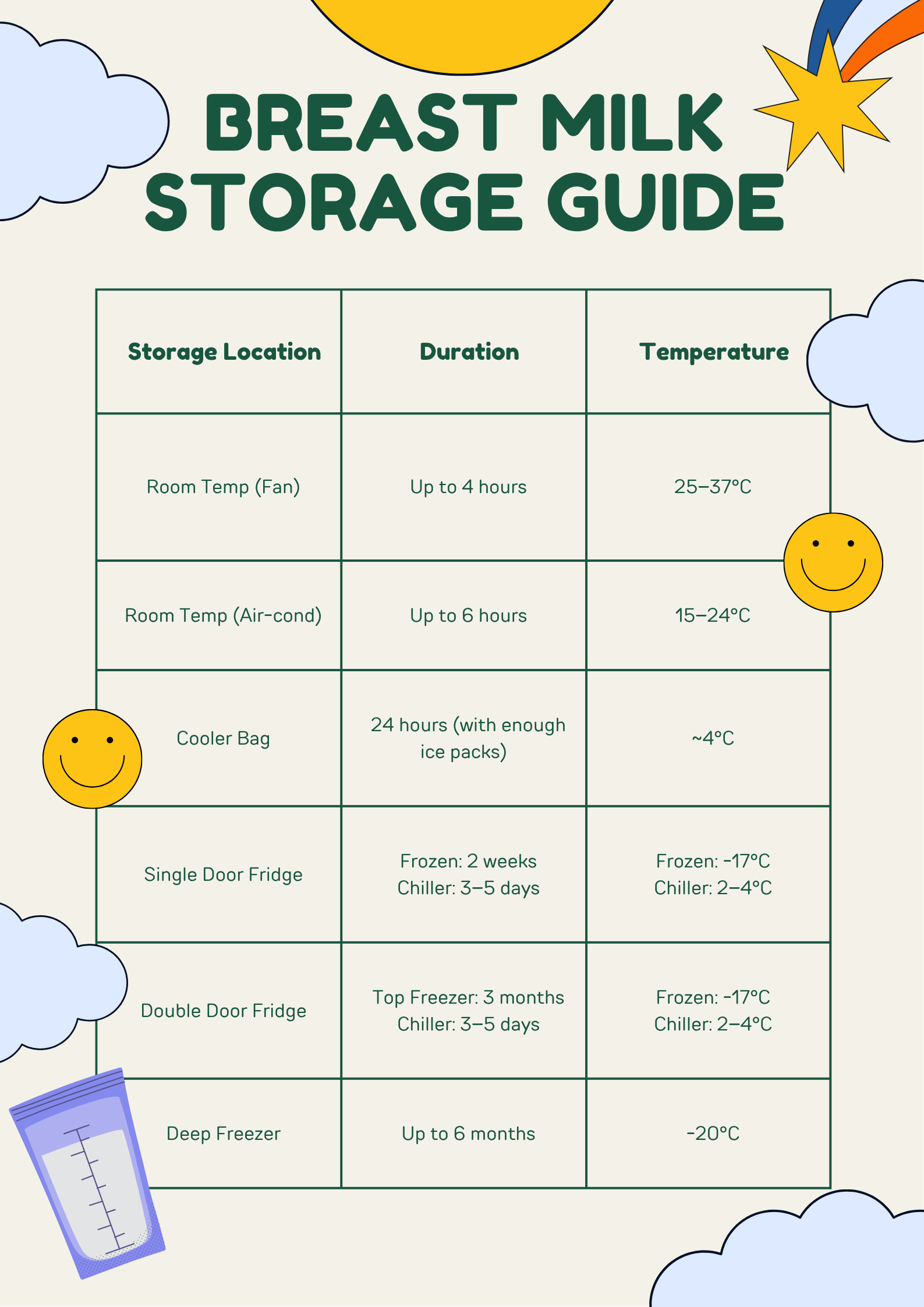
For more information and inquries, please call our Lactation Team at +604 - 373 9191 or visit us Sunway Medical Centre Penang, 3106, Lebuh Tenggiri 2 Pusat Bandar Seberang Jaya, 13700 Perai, Pulau Pinang.








